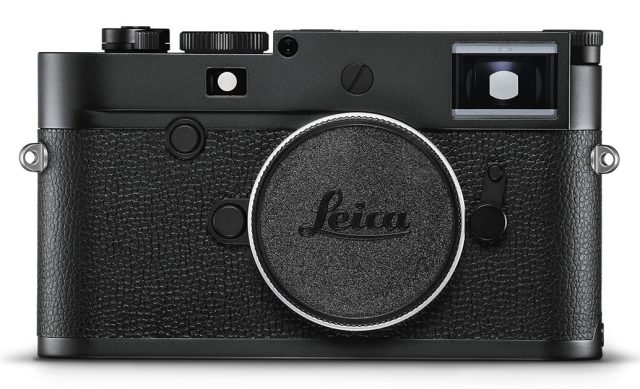Announced
Production status
Order No.
System
Leica M system cameras
- Leica M (Typ 240)
- Leica M (Typ 262)
- Leica M Monochrom
- Leica M Monochrom (Typ 246)
- Leica M-A (Typ 127)
- Leica M-D (Typ 262)
- Leica M-E (Typ 220)
- Leica M-E (Typ 240)
- Leica M-P (Typ 240)
- Leica M1
- Leica M10
- Leica M10 Monochrom
- Leica M10-D
- Leica M10-P
- Leica M10-R
- Leica M11
- Leica M11 Monochrom
- Leica M11-P
- Leica M2
- Leica M3
- Leica M4
- Leica M4-2
- Leica M4-P
- Leica M5
- Leica M6
- Leica M6 (Typ 2248)
- Leica M6 Panda
- Leica M6 Titanium
- Leica M6 TTL
- Leica M6J
- Leica M7
- Leica M8
- Leica M8.2
- Leica M9
- Leica M9-P
- Leica MD
- Leica MD-2
- Leica MDa
- Leica MP
- Leica MP Original
Leica M10 Monochrom
35mm MF digital rangefinder camera • Discontinued
Specification
| Format: | |
| 35mm full frame | |
Imaging sensor: | 36 × 24mm CMOS sensor |
Resolution: | 7864 × 5200 - 41 MP |
Sensor-shift image stabilization: | - |
| Leica M [27.8mm] | |
| Shutter: | |
Type: | Focal-plane |
Model: | Electronically controlled |
Speeds: | 16 - 1/4000 + B |
| Exposure: | |
Exposure metering: | Through-the-lens (TTL), stop-down |
Exposure modes: | Aperture-priority Auto |
| Manual | |
| Rangefinder and Viewfinder: | |
Rangefinder: | Built-in, combined with viewfinder |
Viewfinder: | Built-in, combined with rangefinder |
Finder magnification: | 0.73x |
Actual rangefinder base: | 69.31mm |
Effective rangefinder base: | 50.6mm |
Bright-line frames: | 35mm & 135mm, 28mm & 90mm, 50mm & 75mm |
Parallax compensation: | Yes |
| Physical characteristics: | |
Weight: | 675g |
Dimensions: | 139x80x38.5mm |
| Accessories: | |
Body cap: | 14195 |
| 14397 |
Manufacturer description #1
January 17, 2020 – Leica Camera continues to be a trailblazer in the world of black-and-white photography with the announcement of the new Leica M10 Monochrom. Photographers are now able explore their subjects in vivid tones of monochrome due to the omission of a color filter, resulting in an unparalleled black-and-white photography experience. The newly developed 40-megapixel true black-and-white sensor, new Wi-Fi capabilities and expanded ISO range make room for added creativity with light and contrast, bringing photographers back to the basics with the most up-to-date technology.
Black-and-white photography lends itself to establishing emotional connections between the photographer and subject matter being conveyed. With the absence of color, a photograph conveys intense, vulnerable and timeless messages that speak to the foundation of a scene without the distractions of color.
The ultra-high resolution black-and-white sensor of the M10 Monochrom delivers images with impeccable sharpness and unrivalled resolution of details in all lighting conditions. While reaching these new feats of resolving prowess, the new M10 Monochrom is even more versatile than its black-and-white forebears, with a broadened sensitivity range at both extremes, now achieving ISO 160 to ISO 100,000 – ensuring that its unmatched imaging strengths can be used in new avenues, from the brightest of days to uncovering light in the darkest of nights. Images captured at all ISO settings offer fine-grained rendition of details with a more analog look and feel than a typical color camera set to black-and-white mode. As is the case with all Leica M-Cameras, the new black-and-white sensor pairs perfectly with the full breadth of Leica M-Lenses, showcasing their contrast, resolution and rendition of the finest details. With this combination, photographers can rest assured that the exceptional quality of the monochrome images they capture holds true to the luminance of their subject.
Based on the Leica M10-P, the M10 Monochrom now benefits from a bevy of newfound abilities for the Monochrom line, including a slimmer body, dedicated ISO dial, touchscreen controls, the quietest mechanical shutter of all Leica M rangefinders – analog or digital – and built-in Wi-Fi for wireless connectivity to the Leica FOTOS app on iOS, iPadOS and Android. For the first time in the history of Leica M Monochrom cameras, users can utilize a mobile workflow that gives them direct access to authentic black-and-white images straight from the camera to their favored social media platform – no digital filters required. The FOTOS 2.0 app helps bring Leica users from the decisive moment of taking the picture to the creative moment of processing and sharing the finished photo as seamlessly as possible. This new freedom ensures no boundaries when it comes to capturing and sharing photographs with a Leica camera.
The design of the M10 Monochrom camera body is as loyal to the strict adherence to the black-and-white aesthetic as the image sensor that lives within it. The camera has no Leica red dot logo on the front and all of the usual bold red engravings found on most M cameras have been desaturated to a neutral gray, creating a sleek monochromatic contrast against its bright white engraved numbers. A subtle black-on-black logotype of “Leica M10 Monochrom” on the top plate gives the camera the most minimal branding to avoid distractions. The black-and-white design details combined with the newly blacked-out shutter button and lens release make the M10 Monochrom the stealthiest serial production camera yet from Leica, emphasizing its focus on blending into the heart of the action and capturing the decisive moment.
The M10 Monochrom is built to the highest quality standards expected of a Leica M camera, made almost entirely by hand through the passionate labor of experienced specialists in Wetzlar, Germany with the finest materials, ensuring it can bear even the toughest conditions of use in its stride. The new Leica M10 Monochrom promises to be a long-term companion that delivers an unparalleled experience and impeccable image quality, as timeless as the classical black-and-white photos it creates.
Manufacturer description #2
The Leica M10 Monochrom occupies a special place within the M-System: its newly developed image sensor is designed exclusively for grayscale recordings and offers exceptional fine-detail rendition thanks to its exceedingly high, 40-megapixel resolution.
The fact that no color filter arrays are required means that there are fewer glass and filter layers to impede the transmission of light or cause deflections.
This is especially advantageous in a traditional rangefinder camera, and results in decreased, finer-grained image noise. In addition, the sensor’s enormous sensitivity range of ISO 160 to ISO 100,000 enables recordings with an extremely broad dynamic range – yielding images whose areas of shadow and illumination are clearly defined, particularly when shooting in uneven, high-contrast light.
The Leica M10 Monochrom is the epitome of discretion — which is why we chose to omit the familiar, and potentially eye-catching, red dot. In a similar vein, the “Leica M10 Monochrom” inscription on the top plate is considerably more subtle. The strict omission of any color-inlaid engravings further emphasizes the camera’s monochrome character.
The camera shutter is barely audible, enabling recordings in situations in which other cameras would be too obtrusive. Thanks to its understated appearance, the M10 Monochrom allows photographers to blend into the crowd and capture their subjects without drawing attention.
The Leica M10 Monochrom is hand-crafted by accomplished specialists using superior-quality materials and elaborate methods of engineering.
For example, the camera’s top and base plates are neither stamped nor molded, but milled from solid blocks of brass.
Due to its robust construction, the Leica M10 Monochrom can weather even the toughest external conditions.
‘Made in Germany’ guarantees the utmost quality, reliability and durability, ensuring long-term value and functionality. After all, a Leica is not just a camera, but represents a worthwhile, life-long investment.
Special editions (2)
- Leica M10 Monochrom "Fragment Edition" (20 units) - April 2022
- Leica M10 Monochrom "Leitz Wetzlar" (650 units) - February 2020



